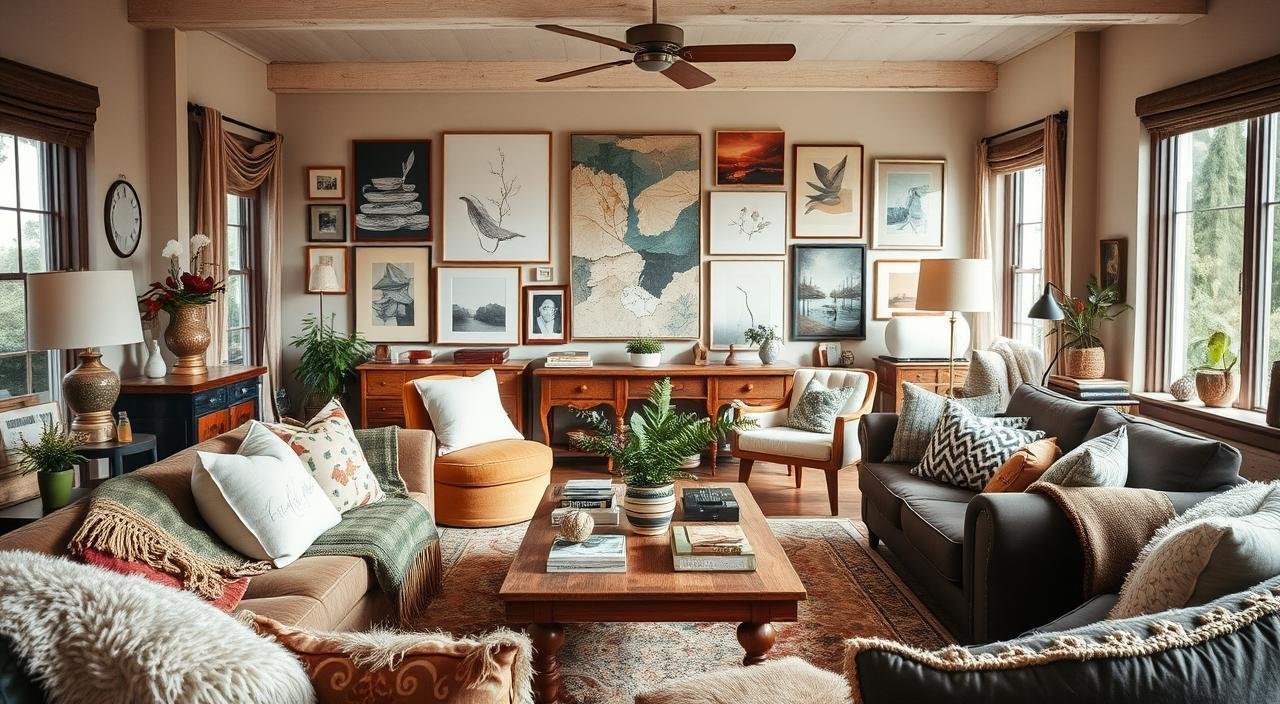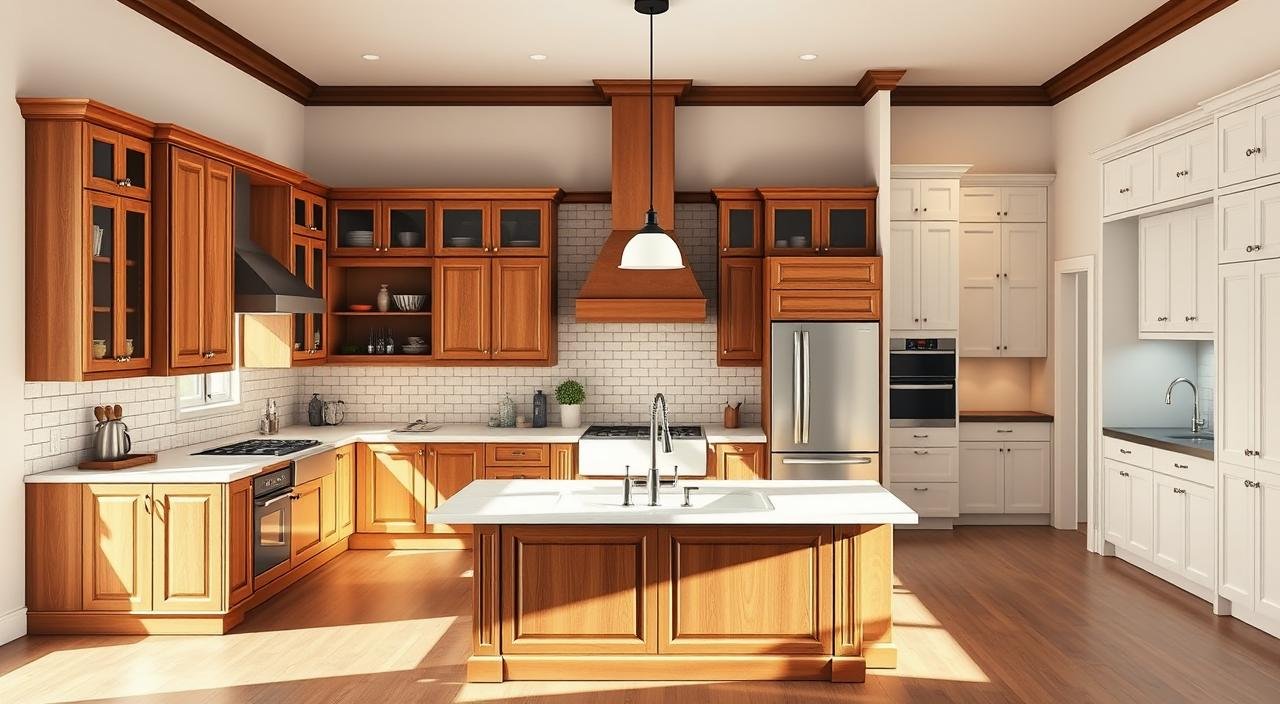Mood Board Inspiration: Refresh Your Home’s Style
Struggling to decide on home decor? Mood boards are your ally for making confident design choices. Picture this: You’re facing a blank wall, unsure of the right paint color. This is where mood board ideas for home come into play. They transform confusion into clarity, blending home decor inspiration with practical steps. This way, even novices can tackle projects with the skill of experts.
Believe mood boards are only for professionals? Think again! An interior design mood board is a collage of swatches, photos, and samples that outline your vision. Whether it’s selecting a Woodchip & Magnolia wallpaper or a Heal’s bed frame, they show how colors, textures, and furniture come together. This is before you spend a single dollar.
Key Takeaways
- Mood boards simplify overwhelming design choices into actionable steps.
- They save time by testing combinations visually—no more buying the wrong rug or paint!
- Use neutral bases like white trays to focus on your samples without distractions.
- Included samples range from Va Va Frome wallpaper to woven rugs and lighting fixtures.
- Even small budgets can use free apps or printed swatches to start—no fancy tools needed!
Understanding the Power of Mood Boards in Home Design
Ever wondered how to transform vague design dreams into a clear vision? Interior design mood boards hold the key. They serve as a visual roadmap, turning abstract ideas into concrete plans. Imagine them as a collage of colors, textures, and patterns—your personal home decor inspiration center!
“The goal of a physical mood board is to see how elements like flooring and hardware work together,” says a pro tip from industry experts. Layering base elements (like flooring samples) under smaller details (like fabric swatches) helps visualize cohesion.
| Element | Purpose |
|---|---|
| Color Swatches | Preview palettes before painting |
| Texture Samples | Test fabric, wood, or tile finishes |
| Furniture Pics | Ensure scale and style harmony |
Tools like Canva make digital creation easy—no art degree required! Drag-and-drop templates allow you to mix patterns or lighting options. Even physical boards (cork or poster boards) are effective. The essence lies in using these boards to question: Does this sofa style match my color scheme? Will that wallpaper overwhelm the room?
Mood boards save money and prevent decor regrets by cutting down on guesswork. Ready to start? Let’s build your vision—no guesswork allowed!
Benefits of Using Mood Boards for Home Styling
Visualizing your dream space doesn’t have to be overwhelming. Mood boards transform abstract ideas into actionable plans, making home styling projects smoother and more enjoyable. They are a game-changer for any project, whether you’re a pro or a DIY enthusiast.

“Once I see the physical components of a room together, I immediately know which items do or do not belong. Could this room benefit from an added color or pattern?”
Clarifying Your Design Vision
Ever felt stuck between farmhouse chic and modern minimalism? Mood boards simplify decision-making. Pin images, fabric swatches, or paint chips to see your style in one place. Pro tip: Start with your favorite room’s vibe and let the board guide your choices—no more endless scroll sessions!
Saving Time and Money on Decor Decisions
DIY mood boards for home styling cut down guesswork. Test a bold accent wall idea digitally or on a physical board before committing to paint. Imagine avoiding that $500 rug purchase that clashes with your sofa! Professionals like Design*Scape swear by this step—saving time equals saving cash.
Communicating Ideas with Designers and Contractors
Words like “cozy” or “modern” mean different things to everyone. Show your tips for creating a mood board for your home to contractors instead of describing. A contractor once told me, “A visual board cuts project delays by 40%—no more misaligned expectations!”
Testing Combinations Before Committing
Swatches of emerald green vs. navy? Lay them side-by-side on your board. Mix patterns or test lighting options without buying anything first. Think of it as a no-risk style lab—your wallet (and your sanity) will thank you.
Essential Elements of an Effective Home Mood Board
Ready to build a mood board that speaks volumes? Let’s break down the five must-have elements pros use to create cohesive spaces. These components turn “I want something cozy” into actionable design steps. Mix and match these parts, and you’ll have a roadmap for your dream room.
| Element | Key Detail | Example |
|---|---|---|
| Color Palettes | 3-4 colors that evoke the mood | Soft greens + cream for a spa-like bathroom |
| Texture Samples | Physical swatches of fabrics, woods, or metals | Granite countertop samples for a kitchen redo |
| Furniture Picks | Showcase anchor pieces | A mid-century dining table sketch |
| Lighting Fixtures | Photos or swatches of fixtures | Copper pendant lights for an industrial vibe |
| Space Layouts | Sketch or app renderings of room flow | A hand-drawn floor plan for open layouts |
Color Palettes That Tell a Story
Pick 3-4 hues that match your vibe. Need inspiration? Pinterest’s mood board examples for interior design tag has thousands of combos. Pair muted grays with gold accents for elegance or bold jewel tones for drama.
Texture and Material Samples
Touch matters! Pin fabric swatches, tile samples, or metal finishes. A home decor mood board template can organize these—think velvety upholstery next to sleek marble.
Furniture and Fixture Selections
Include photos or 3D models of key pieces. Struggling? Use apps like Pinterest to save sofas or dining sets. Prioritize items that define the room’s purpose.
Lighting Considerations
Light transforms spaces. Add photos of fixtures or notes on natural light. A chandelier pic paired with “soft morning light” notes creates clarity.
Architectural Details and Space Planning
Show doorways, windows, or wall placement. Sketch layouts by hand or use tools like Canva’s home decor mood board templates for digital setups. Get spatial clarity before buying!
Stuck? Start with free home decor mood board templates from sites like DesignSponge or HGTV. Mix physical samples with digital pins—they’re your secret tools for a foolproof vision!
Physical vs. Digital Mood Boards: Choosing the Right Format
Ready to start your DIY mood boards for home styling? Let’s explore the advantages of physical and digital formats. This will help you choose the best option for your style.

Physical boards offer a tactile experience. Arrange fabric swatches, paint chips, or home decor mood board templates on a neutral surface like a white foam board. A designer noted, “A plain white tray keeps materials front and center without distractions.” You can feel textures, see color contrasts, and pin samples to adjust layouts.
Digital options stand out for their flexibility. Apps like Pinterest or Canva allow you to collage images, adjust layouts instantly, and collaborate online. Need to tweak a color? Drag and drop! Plus, you can save 100+ ideas without cluttering your desk.
| Physical Boards | Digital Boards |
|---|---|
| Touch real materials | Easy sharing and editing |
| Display as a creative workspace | Access global inspiration instantly |
| Perfect for tactile learners | Organize with search tags |
Hybrid setups are the best! Start with a physical board, then refine it digitally. This way, you can balance creativity and convenience. Remember, the goal is your dream space—no wrong choice here. Ready to begin? Grab a foam board or open Canva—your style adventure starts now!
Step-by-Step Guide to Creating Your First Mood Board
Ready to bring your design dreams to life? We’ll simplify the process into clear steps. Begin by defining your style goals. Ask yourself, “What mood or function do I want this space to have?” Is it cozy relaxation or bold modernity? Write down key words or themes to guide your choices.
“Where to start? This totally depends on your personal preference and process… but for me, I always begin with a digital mood or concept board first,” says interior designer Laura Chen.
Step 1: Gather inspiration widely. Browse magazines, capture textures at parks, or save travel postcards. Creative home decorating ideas are everywhere! Use apps like Canva or Milanote to collect visuals digitally. Drag-and-drop makes rearranging a breeze.
Step 2: Organize with intention. Begin with a neutral backdrop (think whiteboards or digital grids). Then, layer elements. Follow the 60-30-10 rule: 60% dominant colors/textures, 30% secondary accents, and 10% bold pops. If something doesn’t fit your theme, delete it.
Step 3: Test and refine
- Print fabric swatches or paint chips to see how they interact in real light
- Add handwritten notes explaining “why” a photo or pattern matters to your vision
- Share your board with a friend—fresh eyes often spot gaps you missed
Remember, tips for creating a mood board for your home focus on clarity, not perfection. This process empowers you to make confident, intentional choices. Ready to start? Your dream room is just a pin drop away.
Mood Board Ideas for Home: Room-by-Room Inspiration
Ready to transform your space into a personalized masterpiece? Let’s explore curated concepts for every room, beginning with the heart of your home.
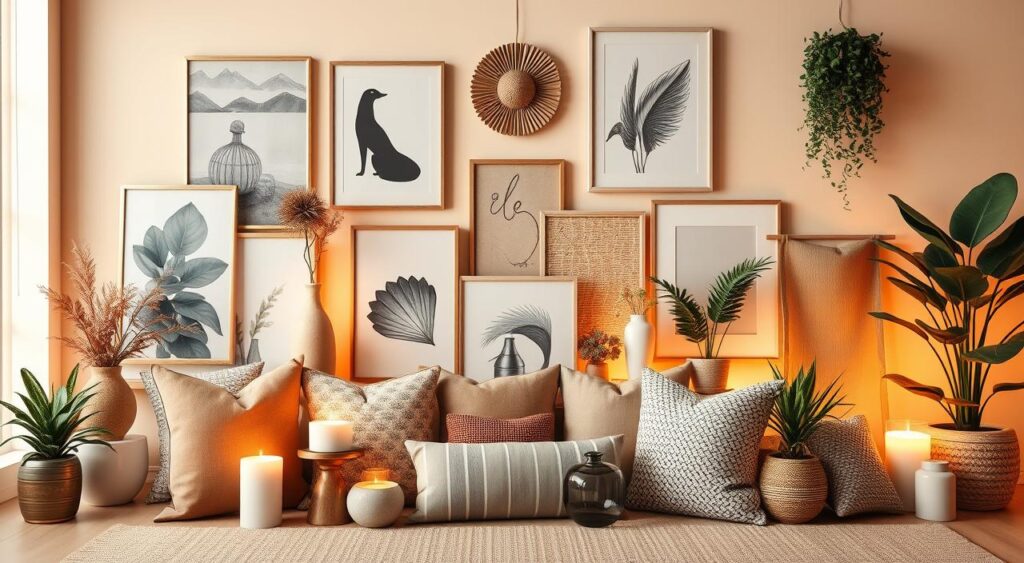
Living Room Mood Board Concepts
For your living room, consider these themes:
- Modern Minimalist: Combine cream-colored L-shaped sofas with matte black accents. Opt for sleek lines and neutral tones for a calm, contemporary look.
- Eclectic Bohemian: Mix global textiles, plants, and earthy ceramics. Blend warm woods with velvet throws for a cozy boho-chic atmosphere.
These mood board ideas for living room design strike a balance between style and function. Whether you prefer simplicity or bold textures, there’s something for everyone.
Kitchen and Dining Space Inspiration
Transform your kitchen into a space that sparks joy:
- Industrial Farmhouse: Combine exposed brick walls with reclaimed wood tables. Add copper accents and open shelving for a rustic charm.
- Classic White: Opt for clean white cabinetry with marble countertops. Use brass hardware and greenery to add sophistication without excess.
Bedroom Sanctuary Designs
Imagine a bedroom that recharges your spirit:
- Pure Tranquility: Choose soft grays, linen bedding, and muted botanical prints. Add dimmable lighting for a spa-like retreat.
- Decadent Dream: Incorporate velvet headboards, gold sconces, and rich wool rugs. Layer textures like silk and faux fur for opulence.
Home Office and Beyond
Blend productivity with style in your workspace:
- Japandi Zen: Combine Scandinavian simplicity with Japanese minimalism. Use bamboo desks, neutral tones, and soft wool rugs for focus-friendly calm.
- Art Deco Edge: Embrace bold geometric patterns, lacquered finishes, and gold accents. Ideal for those who love statement pieces without clutter.
Whether you’re redoing one room or the whole house, these ideas spark creativity. Mix, match, and make every space feel like home.
Incorporating Color Psychology in Your Home Mood Boards
Ever ponder why some rooms feel cozy or invigorating? Let’s explore color psychology to enhance your creative home decorating ideas. Colors aren’t just for aesthetics; they influence our mood. Begin by selecting hues that match the desired atmosphere of a space. For example, blues and greens calm the mind, making them perfect for bedrooms or meditation areas. Reds and oranges, on the other hand, boost energy, ideal for dining spaces to foster engaging conversations.
“Muted and soft tones create tranquil retreats—like a lavender-and-cream palette for a spa-like bathroom,” says a recent study on color in home design.
Here’s a tip: green energizes kitchens (think fresh herbs + sunlight), while purple adds an air of mystery to accent walls. For a balanced look, use a color wheel tool like Adobe Color to select harmonious shades. A pro tip: Pair bold accent walls with neutral bases to prevent overwhelming the space.
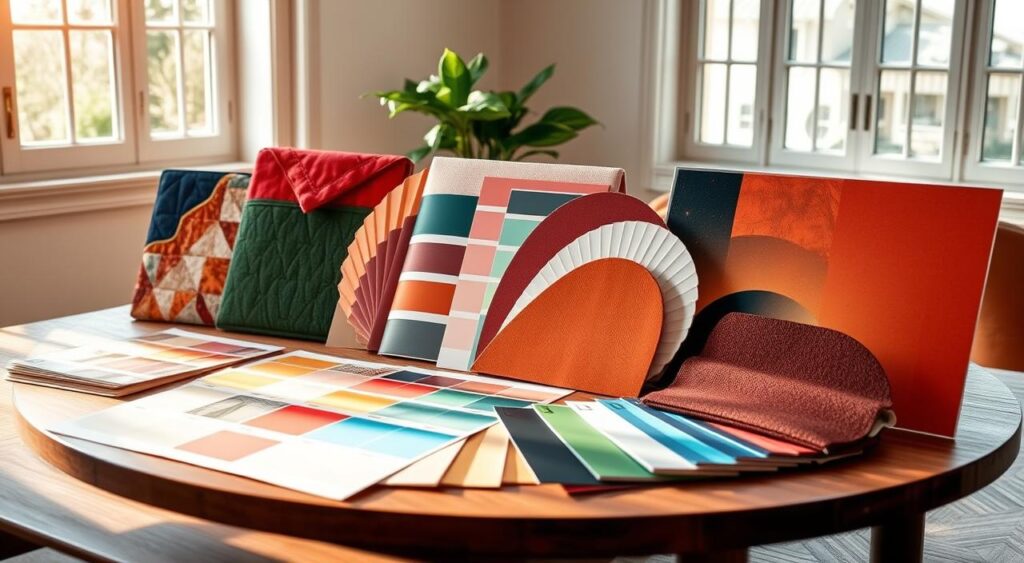
Don’t forget—lighting significantly impacts color perception! Warm tones shine under soft lamps, while cool hues appear vibrant near windows. Test your color palettes on interior design mood boards under actual room lighting before making a final decision. Also, mix textures to add depth—velvet in red is dramatic, while matte whites are calming.
Seasonal Mood Board Ideas to Transform Your Space
Ever wanted to refresh your home without a full renovation? Mood board ideas for home let you update spaces seasonally with ease. Whether you’re a DIY pro or a first-timer, these home decor inspiration tips will help you embrace each season’s vibe affordably. As one designer shared:
“Some of my mood boards are ever evolving til the very end of a project… tweaking details keeps it fresh!”

Spring Refresh Design Boards
Think renewal! Pair soft pastels like the blue and white floral hand block with light fabrics. Add greenery via potted plants or botanical prints. Try a striped accent chair for a pop of color—this season’s all about fresh starts!
Summer Vibrancy and Light
Bring the outdoors in! Layer natural materials like rattan (STONE BROOK LIFT-TOP DESK) and woven baskets. Cool blues and whites mimic seaside vibes—try a blue glass lamp or a blue indoor/outdoor rug. DIY projects like repurposed glass jars add charm. Did you know 40% of DIYers now focus on eco-friendly swaps? Mix indoor/outdoor furniture for a breezy feel.
Fall Coziness and Warmth
Embrace earthy tones: terracotta, deep greens, and warm neutrals. Add texture with wool throws, wood accents (like the HEKMAN BEDFORD PARK console), and metallics. A brass wall sconce or leather nailhead ottoman creates contrast. Swap in autumnal scents with handmade beeswax candles—small changes make big impacts.
Winter Elegance and Comfort
Cozy up with rich fabrics like velvet (JONATHAN LOUIS JACKIE SETTEE) and metallic accents. Cool blues and snowy whites mix with emerald greens for festive flair. A blue and white planter pot or gold window candles add luxury without overspending. Stick to warm neutrals for timeless elegance.
Remember—seasonal updates don’t require big budgets. Swap in textiles, art, or accessories to refresh your space. Your mood board is your guide—adapt, tweak, and make it yours!
Creative Ways to Source Materials and Inspiration
Looking for creative home decorating ideas but unsure where to begin? Explore affordable methods to gather materials and find home decor inspiration in everyday life!
“For anyone outside the trade, luckily you can also easily acquire swatches… I’d always recommend ordering swatches prior to committing.”
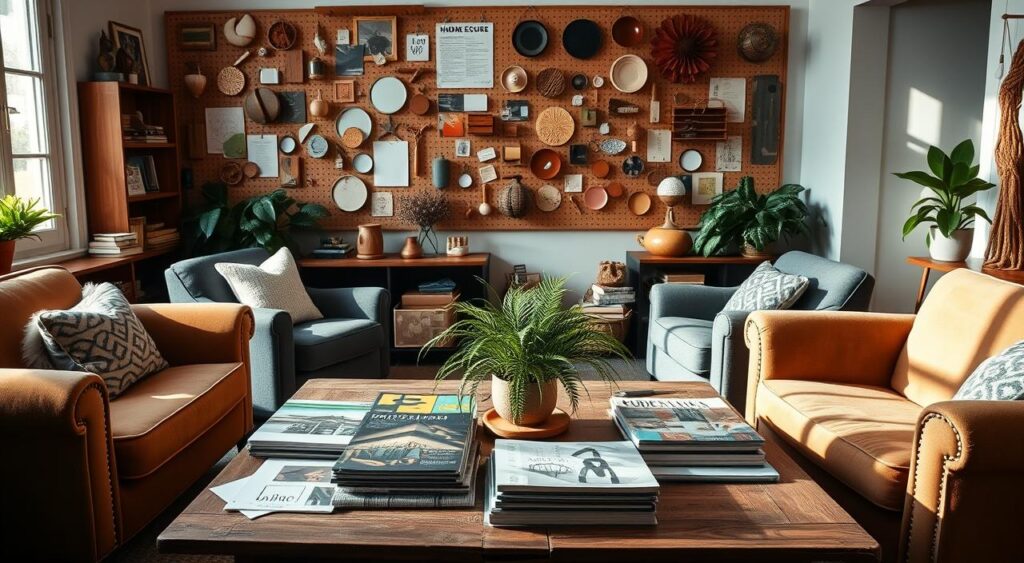
Begin with free or low-cost physical items: paint retailers like Sherwin-Williams offer free sample chips. Thrift stores are treasure troves for vintage textiles and frames. Fabric stores often sell leftover swatches for just $1-2. Nature provides endless inspiration—press flowers, collect pebbles, or capture sunset photos to create color palettes.
| Source | Physical Finds | Digital Tools |
|---|---|---|
| Color Swatches | Paint stores, fabric shops | Coolors.co, Adobe Color |
| Patterns | Old magazines, wallpaper samples | Unsplash, Canva templates |
| Textures | Leaves, wood grains, fabric scraps | Texture overlays in Figma, digital scrapbooking apps |
Online, explore Pinterest boards and Behance portfolios for the latest trends. Download free texture packs from Freepik or capture art from museum websites. Organize your discoveries: use Evernote for digital clips or a shoebox for physical samples.
Remember, inspiration can come from anywhere! Your next home decor inspiration might be in your recycling bin or during a rainy-day stroll. Be bold, mix, and match to create something uniquely yours!
Top Tools and Apps for Creating Digital Mood Boards
Ready to digitize your creativity? Let’s explore the best tools to bring your interior design mood boards to life. Whether you’re tech-savvy or just starting, these apps make the process easy while keeping your vision clear.
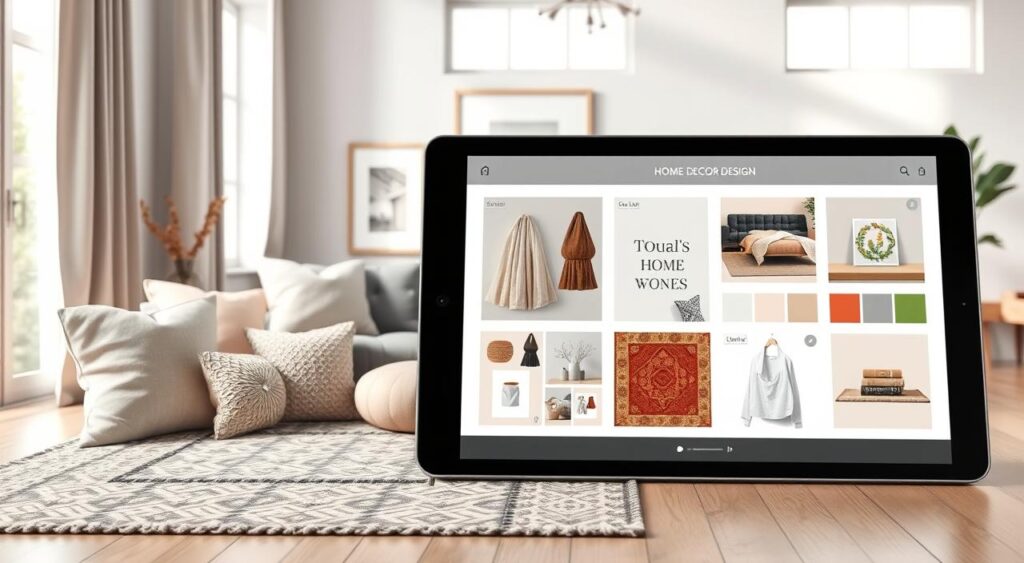
Begin with platforms you already know. Pinterest and Instagram are treasure troves for home decor mood board templates. Use them to save pins, organize boards, and share ideas with others. A pro tip:
Upload a photo of your physical board to your digital file to spot any gaps or overlaps!
Free vs. Premium Apps: What’s Right for You?
| Tool | Features | Best For |
|---|---|---|
| Canva | Templates, drag-and-drop, AI design help | Quick DIYers |
| Milanote | Collaboration tools, video layers | Team projects |
| Adobe Express | Custom layouts, image editing | Professional polish |
| Mural | AI suggestions, real-time feedback | Innovators |
For free starters, try Pinterest or Google Slides. For advanced 3D previews, DesignFiles and Foyr Neo are great. Even PowerPoint works for simple layouts!
Pro Tips for Every Budget
- Use home decor mood board templates from Canva to save time
- Test premium trials before committing
- Combine apps—mix Milanote’s collaboration with Canva’s templates
The right tool empowers, not overwhelms. Choose what suits your style and then explore. Let’s create that dream space, one click at a time.
Common Mood Board Mistakes and How to Avoid Them
Even the best DIY mood boards for home styling can go off track. Let’s break down 4 slip-ups—and how to fix them fast!
“Once I see the physical components of a room together, I immediately know which items do or do not belong.”
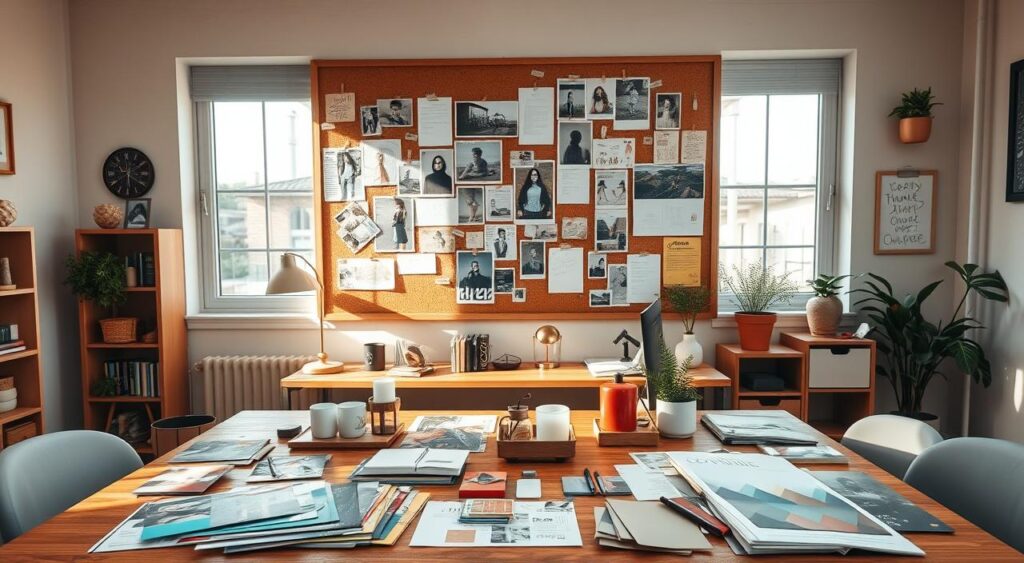
- Overloading your board? Start with 50-100 images but curate down to 20 per room. Tools like Canva or Houzz help focus your vision.
- Ignoring texture and color samples? Physical swatches from stores like Home Depot or Sherwin-Williams prevent “I-wish-I’d-checked” moments. Ever bought a $25 Target pillow only to hate it in real life? Swatches save cash and stress.
- Skipping the budget check? A vibrant digital board might look great—but can you afford those imported marble tiles? Use your board to prioritize costs.
- Rushing to shop? Wait until your board is finalized. A rushed purchase wastes time and money.
| Mistake | Fix |
|---|---|
| Too many elements | Curate to 20 images/room |
| No physical samples | Touch fabric swatches and paint chips |
| Ignoring budgets | Price-check materials costs early |
Remember: DIY mood boards for home styling are your roadmap—not a final destination. Adjust as you go, but keep your core vision in sight. Your dream room starts with a smart plan!
Transforming Your Mood Board into Reality: Implementation Tips
Ready to bring your mood board to life? Let’s dive into the steps to make every design choice count. Your creative home decorating ideas need a solid plan to avoid last-minute stress.
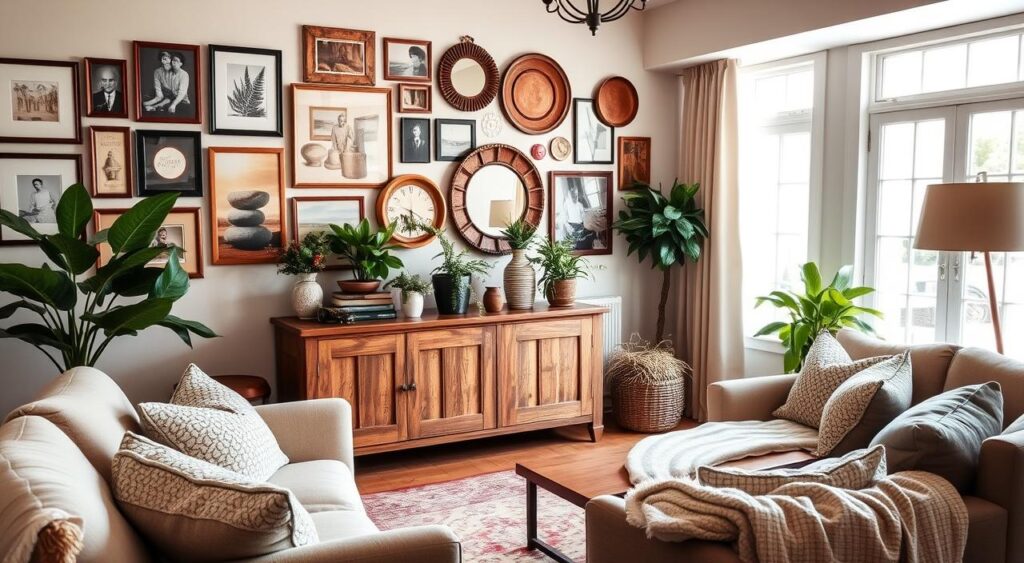
“Once you’ve nailed down a mood board you feel happy with, you can begin ordering components with confidence. It gives control and ensures no surprises on delivery day.”
Begin by turning your vision into actionable steps. Here’s how:
setting a realistic budget and timeline>Break down costs for each mood board element. Use free tools like Pinterest or Houzz to compare prices. Set milestones—like “paint week” or “furniture delivery date”—to stay on track. Budget 10% extra for unexpected costs.
prioritizing key elements>Focus first on foundational items: paint, flooring, or large furniture. For example, start with a bold Deccoprint wallpaper (like their geometric patterns) to anchor the room. Save smaller decor for later—this builds momentum without overspending upfront.
working with professionals vs diy approaches>Decide whether to DIY or hire help. Here’s how to choose:
| Option | Best For | Cost Range |
|---|---|---|
| Hiringing a Pro | Custom carpentry, plumbing | $500–$3,000+ |
| DIY | Painting, decor assembly | $50–$200 |
Share your mood board with contractors using Pinterest links to clarify your vision.
adapting your plans as you go>Hit a snag? Swap a pricey rug for a DIY runner. Can’t find that perfect chair? Opt for a similar style. Flexibility keeps your project on track while staying true to your tips for creating a mood board for your home.
Remember: Your mood board is a roadmap, not a rulebook. Celebrate each step—your dream space is within reach!
Conclusion: Bringing Your Dream Home to Life Through Thoughtful Mood Boarding
Your journey to a cohesive, stylish home begins here. Mood boards transform vague ideas into concrete plans. They blend neutral palettes like terracotta and linen textures, creating spaces that feel deliberate. Each swatch and sketch moves you closer to a room that mirrors your personality.
Even small choices, like pairing wood accents with soft greens, contribute to a sanctuary. This space feels both serene and purposeful.
Ready to start? Begin with a small step: sketch a vignette or use free tools like Canva for mood board ideas. For minimalist design tips, visit 17 Vibes’ minimalist decor guide. It offers inspiration that balances form and function. Share your progress in the comments—I’d love to see how you incorporate materials like ceramic or woven textiles into your vision.
Design is about progress, not perfection. Whether you’re reimagining a kitchen or a cozy reading nook, your mood board is your guide. Every texture sample, color chip, and furniture sketch brings you closer to a space that feels like home. So, grab a magazine, open that design app, and let your boards lead you to a room that’s as unique as you are. Your dream decor is within reach—what’s your first pin?
FAQ
What is a mood board, and how can it help with home decor?
Can I create a mood board if I’m not a professional designer?
How do mood boards save time and money when decorating?
What should I include in my home mood board?
What’s the difference between physical and digital mood boards?
How can I gather inspiration for my mood board?
What are some common mistakes to avoid when creating a mood board?
How can I turn my mood board into a reality?

AUTHOR: MARIA JOSE VENTRAMELI
Specialist in Home Design, Architecture, and Trends
With years of experience writing for top home and lifestyle blogs, she now contributes to 17Vibes, offering practical, research-backed insights on renovations, smart technology, sustainable building, and modern living trends. Join our Facebook community here
